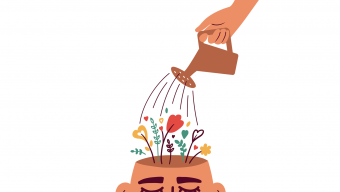Even before COVID-19 arrived and turned our lives upside down, we were facing an epidemic of mental health issues. In fact, the World Health Organization has named stress the most prevalent problem in the 21st century – and this stress does not come from an increase in pathologies but an increase in our inability to adapt to the difficulties of life. Furthermore, depression is projected to be a major contributor to disease and disability around the world by 2030.
And now, thanks to the pandemic, we are all struggling with one kind or another of unease: anxiety, depression, social isolation, burnout, or simply the general stress that comes with not knowing what to expect next. Adam Grant labelled this common mood of 2021 “languishing” because the pandemic has left many of us drained and with a sense of stagnation and emptiness. When we’re languishing, it’s difficult to find motivation and everything feels exhausting. Any task seems too demanding of energy for too little in return. Thus, it is safe to say that “languishing” is the opposite of thriving.
A growing body of research shows that resilience is one of the best capacities we can build in order to prevent stress and depression. It is the single most important personal skill a person can develop to live a happier, healthier, and more fulfilling life. In psychology, resilience is considered a healthy response to adversity and the ability to face a critical situation, overcome it, and emerge stronger. However, resilience is not a universal phenomenon. Not everyone that goes through a negative experience is able to successfully cope with it and rise from it stronger. Some people are simply more resilient than others.
I first encountered the concept of resilience as a mother. When you have children, it’s devastating to see them hurting, eyes brimming with tears when turned down by their playmates or frustrated by failure. Yet, it’s impossible to protect them from the disappointment that comes from experiencing setbacks or rejection. So, I started to look for ways to help them reframe these disappointments and face obstacles in a more constructive way. I wanted to give them the skills to not only get over their difficult times but to bounce forward feeling more confident as a result.
Scientists had been studying resilience, in a professional capacity, for years. It’s what Martin Seligman, the “father of positive psychology,” considers to be a necessary new trend that moves the discipline away from focusing on what is “wrong” with individuals towards trying to understand what makes them stronger. Positive psychology studies what circumstances facilitate or prevent a person from being able to transform a traumatic experience into positive learning. Optimism, hope, a sense of humor, gratitude, self-confidence, and an extroverted character are all considered protective factors that facilitate resilience. Research shows that there are some ways of acting and thinking that improve our wellbeing and overall resilience.
Optimists believe that even if something is irreversible, the way we feel about it will continue to change and evolve.
Resilience is an ability that can be taught and trained and, as with any kind of training, practice is key. A big part of that practice is developing a positive mindset. As Sir Winston Churchill famously said, “Attitude is a little thing that makes a big difference.” What we think about impacts what we believe is possible, the challenges we pursue, and the risks we dare to take in life.
An optimistic attitude is the first step towards resilience and, according to Seligman’s definition of optimism, there are some things that optimists do differently. For example, optimists don’t ignore the negative aspects of life. In fact, it’s quite the opposite. When misfortune lands upon an optimist, they tend to quickly move from thoughts of ‘Why is this happening to me?’ to ‘And now, what can I do?’ This proactive behavior is a way in which optimists focus on the aspects of the situation they can control and accept that which they can’t control. By doing so, they put their best efforts into the tasks that can make an impact and avoid getting drained from fixating on things that are simply not actionable.
Furthermore, optimists are able to recognize the impermanence of time and believe that even if something is irreversible, the way we feel about it will continue to change and evolve. This is a result of what Daniel Gilbert calls our psychological immune system that reduces the emotional power of any event through the processes of assimilation, accommodation, and explanation.
And of course, optimists tend to have a healthy sense of humor that helps defuse pain. We are all going to be hit by the same feelings of fear, grief and, sadness; it’s how long we stay in those feelings what counts. There are other things that can help improve our emotional and mental fitness and increase our resilience:
- Move your body. Science has proven that body and mind are linked and thus we can’t change one without changing the other. Physical activity reorganizes the brain so that it can better cope with stress and anxiety. It also triggers the brain’s reward response through the release of endorphins. Moving can lend a new perspective – literally and figuratively – philosophers have been walking to think for centuries.
- Practice gratitude. We are cognitively primed to look at things in a way that focuses on the negative – it’s an adaptive way of thinking inherited from our ancestors. The ‘three good things exercise’ is a way to intentionally refocus your attention on the positive that happened that day. Once a day, for at least an entire week, write down three good things that happened to you and, better yet, include a short explanation as to why you think they happened. With this practice, it becomes easier to focus on the positive and less on the negative.
- Connect with others. We are social beings; we need friends, we need connection. It is therefore important to cultivate strong and meaningful relationships with the people in your life. In fact, having just one person in your life with whom you can connect makes you ten times less likely to feel depressed. Loneliness also affects our body and can be as bad for our health as smoking 15 cigarettes per day. It is therefore essential to take the time to build our social relationships.
- Lend a hand. Eleanor Roosevelt said that the surest way to happiness was to seek it for others. Being part of something larger than ourselves gives us purpose and a reason to continue fighting every day. According to social psychologist Jonathan Haidt, author of The Happiness Hypothesis, we are 90% ape and 10% bee, which means we are, at the same time, self-interested and able to work for the good of the group. It turns out that these group experiences are among the most cherished of our lives.
There are, and always will be, many factors that are out of our hands. COVID-19 brutally reminded us of that. Yet, even though we don’t have control over the whole game, the way in which we choose to play is always up to each one of us. We can choose to use adversity as a catalyst to bounce forward – but this doesn’t mean that the process is going to be pain-free or quick. It takes a certain strength: resilience. When we do the consistent work of building and practicing resilience, the reward is wellbeing, overall life satisfaction, and the realization of our personal goals. In this way, we have the opportunity to not only change ourselves but to be an inspiration for others.
© IE Insights.








